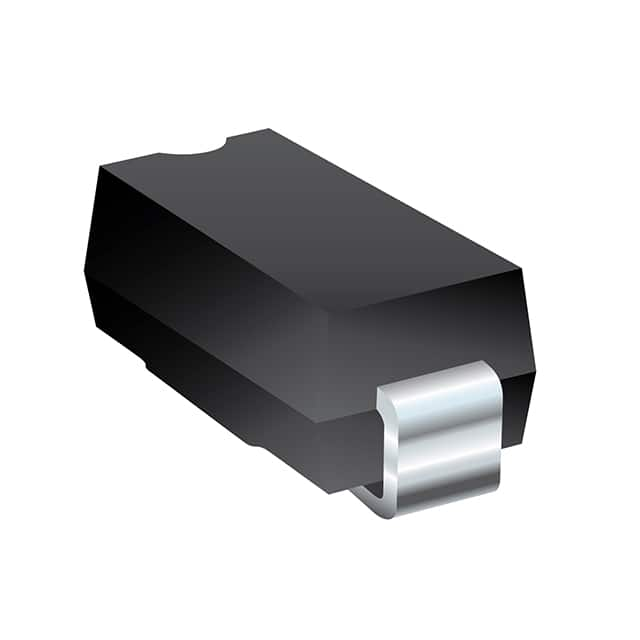Lihat spesifikasi untuk detail produk.

SMAJ5.0A Diode - Encyclopedia Entry
Introduction
The SMAJ5.0A diode is a crucial component in electronic circuits, belonging to the category of semiconductor devices. This entry provides an overview of its basic information, specifications, pin configuration, functional features, advantages and disadvantages, working principles, application field plans, and alternative models.
Basic Information Overview
- Category: Semiconductor device
- Use: Rectification and voltage regulation in electronic circuits
- Characteristics: Fast response time, low leakage current, high surge capability
- Package: SMA (DO-214AC)
- Essence: Protecting electronic circuits from voltage surges and transients
- Packaging/Quantity: Typically available in reels of 3000 units
Specifications
- Voltage Rating: 5.0V
- Peak Pulse Power: 400W
- Breakdown Voltage: 6.4V
- Maximum Clamping Voltage: 9.2V
- Operating Temperature Range: -55°C to +150°C
- Storage Temperature Range: -55°C to +150°C
Detailed Pin Configuration
The SMAJ5.0A diode has two pins, typically denoted as the anode and cathode. The anode is connected to the positive terminal of the circuit, while the cathode is connected to the negative terminal.
Functional Features
- Transient Voltage Suppression: Provides protection against voltage spikes and transients.
- Fast Response Time: Reacts quickly to voltage surges, diverting excess energy away from sensitive components.
- Low Leakage Current: Minimizes power loss during normal operation.
Advantages and Disadvantages
Advantages
- Effective protection against voltage surges
- Fast response time
- Low leakage current
Disadvantages
- Limited peak pulse power handling capability
- Requires careful consideration of placement in circuits to ensure optimal protection
Working Principles
The SMAJ5.0A diode operates based on the principle of avalanche breakdown. When a voltage surge occurs, the diode rapidly conducts, diverting the excess energy away from the protected circuit. This action prevents damage to sensitive components.
Detailed Application Field Plans
The SMAJ5.0A diode finds extensive use in various applications, including: - Power supply units - Communication equipment - Automotive electronics - Industrial control systems - Consumer electronics
Detailed and Complete Alternative Models
Several alternative models to the SMAJ5.0A diode include: - P6KE5.0A - 1.5KE5.0A - SMBJ5.0A - SMCJ5.0A
In conclusion, the SMAJ5.0A diode serves as a critical component in protecting electronic circuits from voltage surges and transients. Its fast response time, low leakage current, and high surge capability make it a valuable asset in various electronic applications.
Word Count: 410
Sebutkan 10 pertanyaan dan jawaban umum terkait penerapan SMAJ5.0A dalam solusi teknis
What is SMAJ5.0A?
- SMAJ5.0A is a type of surface mount transient voltage suppressor diode designed to protect electronic circuits from overvoltage events.
What is the maximum voltage rating for SMAJ5.0A?
- The maximum voltage rating for SMAJ5.0A is 5.0 volts.
What is the typical application of SMAJ5.0A?
- SMAJ5.0A is commonly used in electronic circuits to protect sensitive components such as integrated circuits, transistors, and other semiconductor devices from voltage spikes and surges.
What is the peak pulse power handling capability of SMAJ5.0A?
- The peak pulse power handling capability of SMAJ5.0A is typically around 400 watts.
How does SMAJ5.0A provide overvoltage protection?
- SMAJ5.0A operates by diverting excessive current away from sensitive components when an overvoltage event occurs, thereby protecting them from damage.
What are the key features of SMAJ5.0A?
- Some key features of SMAJ5.0A include its compact surface mount package, low clamping voltage, fast response time, and high surge capability.
Can SMAJ5.0A be used in automotive applications?
- Yes, SMAJ5.0A can be used in automotive electronics to protect against voltage transients and surges.
What are the temperature specifications for SMAJ5.0A?
- SMAJ5.0A typically has an operating temperature range of -55°C to 150°C, making it suitable for a wide range of environments.
Is SMAJ5.0A RoHS compliant?
- Yes, SMAJ5.0A is generally compliant with the Restriction of Hazardous Substances (RoHS) directive, making it suitable for use in environmentally conscious applications.
Where can I find detailed specifications and application notes for SMAJ5.0A?
- Detailed specifications and application notes for SMAJ5.0A can usually be found in the product datasheet provided by the manufacturer or supplier.

